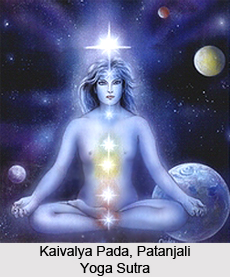 Kaivalya Pada is the fourth and the final chapter of Patanjali Yoga Sutra. The three components of Indian philosophy have been laid down systematically in the unique way of Patanjali. The components of Kaivalya Pada are 'Bhakti Marga', 'Karma Marga', and 'Jnana Marga'. In Kaivalya Pada, the path of renunciation or the 'Vairagya Marga' is elaborately explained.
Kaivalya Pada is the fourth and the final chapter of Patanjali Yoga Sutra. The three components of Indian philosophy have been laid down systematically in the unique way of Patanjali. The components of Kaivalya Pada are 'Bhakti Marga', 'Karma Marga', and 'Jnana Marga'. In Kaivalya Pada, the path of renunciation or the 'Vairagya Marga' is elaborately explained.Kaivalya means exclusiveness, or eternal emancipation. Kaivalya Pada describes an absolute, indivisible state of existence of the 'Yogi'. The yogi is free of thoughts, mind, intellect and ego and also freed from the intricacies of the 'gunas' of nature like, 'sattva', 'rajas' and 'tamas'. The chapter of Kaivalya Pada is both impressive and exhaustive. One of its main themes is that the content of consciousness is pure, absolute and divine, provided it remains unblemished by action; be it white ('sattvic') grey ('rajasic') or black ('tamasic'). The absolute nature of consciousness is to be realised by propitious birth, spiritual fervour and meditation.
Kaivalya Pada opens with the contention that prodigious yogic powers may be inborn, acquired by merit accumulated through practice in former lives. They may also be attained through use of herbs ('ausadhi'), incantation ('Mantra'), devoted discipline ('tapas'), meditation ('dhyana') and total absorption ('Samadhi'). In these five types of yogis, nature's energy, which later becomes known as 'Kundalini', flows with ever-increasing abundance, preparing them to receive the infinite light of the soul. This is why tapas and Samadhi are held to be the best of the five; they provide a firm foundation for stable growth, which prevents the yogi from misusing the energy built up through his practices. For ensuring safety the yogis employ method and restrain so as to use nature's energy ('Shakti'), intelligently to gain wisdom.
In other chapters of Patanjali Yoga Sutra, it is pointed out that nature is eternal and its qualities or gunas are ever-changing. Kaivalya Pada further says that this blending of the gunas creates diversity in the mind so that it sees objects in different ways. The object is the same and the mind, too, is the same. But the same mind has many qualities of mood and behaviour. This fragmentation is the cause of 'Avidya'. The mind divided by the gunas moulds and re-moulds man. The study of subject and object helps the student to perceive with prejudice, and facilitates him to be aware of the objects exist independently, irrespective of his cognition of them.
The last word used in 'Vibhuti Pada' is Kaivalyam, which denotes detachment from the material world. There are almost thirty-four 'Sutras' under this section that guides the Yogi step by step, about what comes after Samadhi. After reaching this stage, the individual gains an amazing feeling of being united with the universe. There are no sorrows or happiness and there is only peace and contentment for the one who has successfully attained Kaivalyam. However, it is clearly mentioned in Kaivalya Pada that this should not deter the Yogi from living his life normally. A person continues to do all their material duties however without keeping any high expectations or with the greed for anything materialistic.
For more, visit the link below: